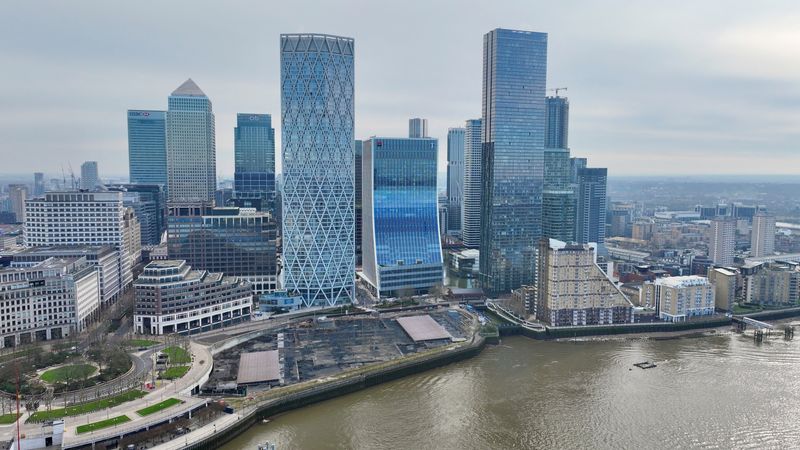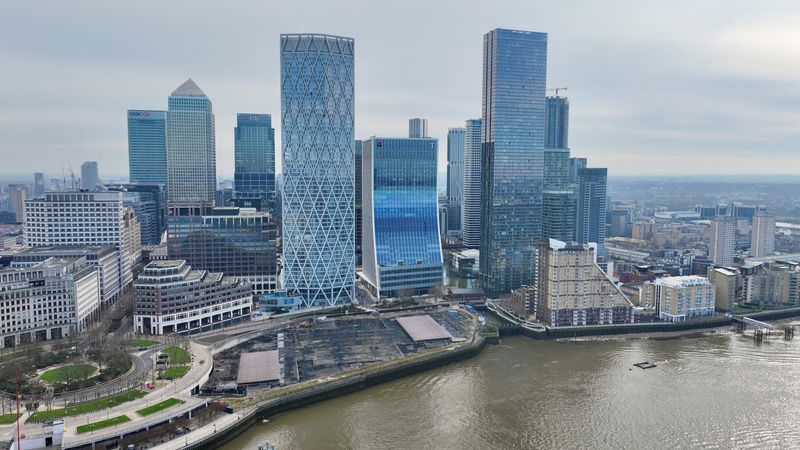
By Naomi Rovnick, Nell Mackenzie and Yoruk Bahceli
LONDON (Reuters) – Investors who had been enjoying a brief rebound in long-suffering UK markets are hunkering down for a stretch of losses as ructions in the pound, government bonds and stocks feed on each other and put Britain at risk of a wave of hedge fund attacks.
As global borrowing costs rise in a trend led by the U.S. Treasury market, the UK’s high-debt, low-growth economy that just months ago appeared to be shrugging off years of post-Brexit gloom is now viewed as vulnerable to capital flight.
Traders now expect months of volatility for the pound, which ended 2024 as the top-performing major currency against the dollar due to optimism that the Labour Party’s landslide July election win marked the end of years of political instability.
That is creating a negative feedback loop by sapping interest in UK stocks that now face fresh currency risks, and casting doubt over Bank of England interest rate cuts, threatening already stagnant economic growth as the nation’s debt burden rises.
There are signs that the pain will be sustained. Options trading data and evidence from hedge fund industry insiders and securities dealing desks point to speculators having piled into bets against the pound and UK gilts.
“I don’t think it’s going to end quickly,” Brandywine Global fixed income portfolio manager Jack McIntyre said of the UK rout, noting that investors remain scarred by memories of the 2022 gilts and sterling crisis sparked by former Prime Minister Liz Truss’ mini-budget.
The U.S.-based asset manager said he had taken on exposure to UK gilts on the basis that these assets would benefit from rate cuts, but hedged this with contracts that profit if sterling, now 2.5% lower versus the dollar this month, keeps falling.
BUYERS’ STRIKE
Just months ago, UK markets were shining as a beacon of stability amid political chaos in France and seemed poised to recover from a long period of government turmoil, currency volatility and being shunned by overseas investors.
January’s market moves were “refocusing the minds of many around the world on Britain, its economic and its financial condition,” said Mario Monti, the economist who was tapped in 2011 to lead Italy as it faced financial implosion.
Long-term UK borrowing costs have touched 27-year highs and the domestically focused FTSE 250 share index is down almost 6% since August. A gauge of buying protection against sterling volatility is near its highest since March 2023.
“The UK is more vulnerable to a buyers’ strike post-Brexit because it is a less core holding for many global investors and it has a less obvious growth story,” U.S. investment bank Evercore ISI vice-chairman Krishna Guha said by email.
Bank of America this week warned of “a significant worsening of the situation that could lead to disorderly moves in gilts (and) sterling, in turn souring growth sentiment and impacting equities negatively.”
‘WEAKEST LINK’
Surging debt costs have hampered finance minister Rachel Reeves’ plan to revive growth via public investment, while sterling’s drop has put the BoE in a bind in case rate cuts fuel more currency weakness, raising import cost inflation.
“As a low-growth economy with relatively high interest rates, the UK is sailing very close to the wind,” UBS investment bank head of G10 FX strategy Shahab Jalinoos said.
“In a world of rising interest rates, it’s trading like the weakest link.”
Political sentiment is febrile again too, as polls indicate a popularity surge for Brexit campaigner Nigel Farage’s Reform Party, while Labour leader Keir Starmer’s ratings plummet.
“The political instability that we thought we were done with when the (July) election happened is back,” Janus Henderson European equities manager Tom Lemaigre said.
He expected renewed sterling volatility that might deter foreign investment into UK stocks exposed to currency risk.
HEDGE FUNDS CIRCLE
“Hedge funds are now selling sterling and selling gilts,” Artemis Fund Management portfolio manager Liam O’Donnell said.
“It’s active money, active short selling coming into the market,” he added, referring to the practice of borrowing securities in the hope of selling them and then buying them back more cheaply.
Brokers are charging fees of up to 30 basis points (0.3%) for lending gilts to speculators, almost double the 10-year average, reflecting heightened demand from short sellers, data from S&P Global Market Intelligence showed.
Trend-following hedge funds called CTAs are mostly betting against the pound and UK gilts, JPMorgan said in a client note.
The UK’s lagging growth had lured “a subset” of hedge funds into short-selling sterling, Franklin Templeton Investment Solutions senior research analyst Tom Finnerty said.
Nevertheless, some view the selling wave as an opportunity.
“I think pessimism is now extreme,” said Mario Unali, head of investment advisory at hedge fund investor Kairos.
He was looking at taking on UK exposure in the next few months, he said.

